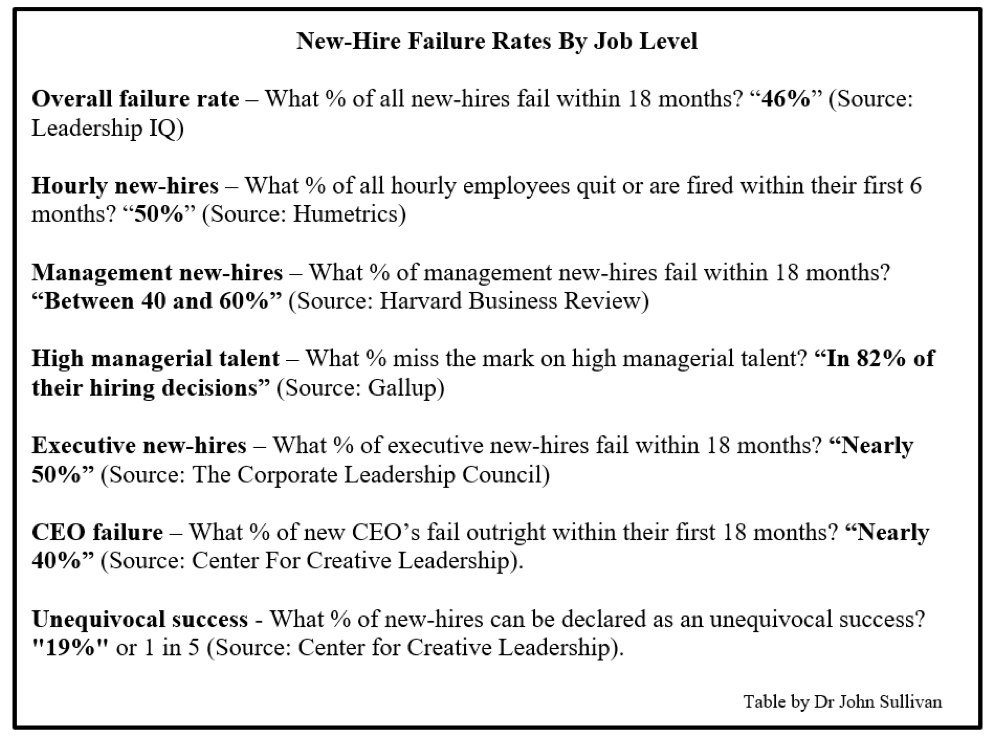Large corporations have thousands of business processes, but I doubt that you’ve ever heard of a single process that has a 50 percent failure rate. So your firm’s executives will be shocked to learn that the recruiting process (the HR process with the highest business impact) often has a failure rate of 50 percent. And that astonishing failure rate occurs at every job level, from hourly employees, to managers, and even at the executive level. You don’t have to be a CFO to calculate the tremendous dollar costs, negative business impacts, and the lost productivity that results from each and every hiring failure. So assume for a minute that you are a corporate executive and then consider what your response would be when you were presented with the following revealing table.

The reported failure rates at the six job levels presented above were reported by five different independent organizations. This consistency indicates that this high failure rate is not a statistical anomaly.
What in the Hell Is Going on in Recruiting?
If you understand the common business process success measure Six Sigma, you know that in layman’s terms it means that a little higher than three errors occur per million tries. The failure rate in these five job level areas ranges from a low of 40 percent and a high of 82 percent (or an average of 500,000 errors per million hires). Obviously, even if the reported failure rates are off by a significant margin, something is seriously wrong with the results produced by most corporate recruiting processes. If the business processes of production, customer service, marketing, or product design had anything close to these failure rates, heads would roll and budgets would be slashed. Yet recruiting leaders march on oblivious to the damage that these bad hires are doing to their corporation.
Selection decisions are often about as accurate as a coin flip. ––The Recruiting Roundtable
The Causes of These Unacceptably High New-hire Failure Rates
There are literally dozens of reasons why failure rates are not measured in recruiting. However, the six most impactful reasons include:
- No measurement of the cost of a bad hire — executives at all levels only demand change when they see that it’s costing them revenue. If they realized that the cost of a hiring failure can easily reach three times the salary for the position, they would demand immediate action. And if the new hire interacts with customers, the costs are much higher.
- Process design isn’t scientific — almost all corporate recruiting processes are designed based on past practices or intuition. Unfortunately, it is quite rare for recruiting processes to be designed from the ground up based on correlation data that reveals which process elements accurately predict future success on the job. Without using process reengineering principles, it is unlikely that recruiting results will improve.
- Intuition rather than data-based decision-making — in my research I have found that over 75 percent of the decisions made during most corporate recruiting processes are made by humans relying on their own intuition, rather than data. And unfortunately, even when recruiting executives are presented with data, they seldom take immediate action.
- Process updates are a hodgepodge — most corporate recruiting processes are literally never periodically redesigned based on business process engineering principles. Instead, elements of the process are added, removed, or modified on an individual basis, and often only when a major issue or new vendor offering comes along.
- Hiring failure rates and quality of hire are not even measured — although it is a standard business process step, I estimate fewer than 10 percent of corporate recruiting functions systematically measure and report their process failure rates. And if you don’t measure hiring failures, you can’t use “root cause analysis” to find out and fix the causes of that failure. And since a majority of recruiting functions don’t even measure quality of hire (the on-the-job performance of new-hires), they also have no way of knowing when a new-hire was a success.
- HR is not a data-driven function — because very few things in HR are data-driven. It’s not surprising that recruiting and all other processes in HR have not shifted to a data-driven approach. Without pressure from the rest of HR, there is little reason for recruiting to proactively become data-driven.
Additional High-Impact Failures In Recruiting
Even if you choose to ignore new-hire failures, recruiting fails in many other areas too. A small sample of those failures include:
- Application process drop out — “The typical Fortune 500 company loses 9 out of 10 qualified applicants to these unwieldy processes” (Source: Indeed survey)
- Interviews don’t predict — We looked at tens of thousands of interviews results … and how that person ultimately performed in their job. “We found a zero relationship. It’s a complete random mess” (Source: Google)
- Managers regret hiring decisions — “66 percent of hiring managers come to regret their interview-based hiring decisions” (Source: DDI)
- Qualified applicants — A majority of managers surveyed “believe that less than half of all candidates that they interviewed were qualified” (Source: eBullpen LLC).
- Resume sorting — Of all the “perfect resumes” sent out by mystery shopper candidates, only 12 percent of these “ideal candidates” were actually scheduled for interviews (Source: Hodes’ Healthcare)
- Promoted executives — “40 percent of newly promoted managers and executives fail within 18 months of starting a new job” (Source: Manchester Inc.).
Define New-hire Failure
Because every situation is different, corporate recruiting leaders need to work with executives to determine the definition of a “hiring failure” that is most appropriate for their organization. Some of the factors (negative things that occur within 18 months of hiring) that others have included in their definition of the hiring failure include:
- Terminations — new hires that must be terminated or forced out.
- Turnover — early voluntary turnover among above-average-performing new hires.
- Job performance — new hires that perform at below average or unacceptable levels or new-hires who must be put on a performance management program.
- Training — new hires who must be provided with significant unanticipated training.
- Up to speed — a time to meet minimum productivity standards that are 50 percent above average.
- Salary cost — salary waste when a new hire who is paid above the midpoint underperforms.
- Movement — a new hire who must be redeployed because they didn’t fit their initial team.
- Legal issues — complaints or legal issues as a result of the employee’s hiring process.
- Manager satisfaction — a high percentage of dissatisfied hiring managers.
- Diversity — unacceptably low diversity among new-hires in customer impact positions.
Final Thoughts
Although few corporations measure new hire failure rates, a significant number also inexplicably fail to measure the on-the-job performance of new hires (i.e. quality of hire). If your goal is to increase the business impacts of recruiting, measuring the percentage of new hires that are above average performers is probably an even more important measure. Work with the CFO’s office to calculate the dollar impact of each bad, weak, or top performer/innovator new hire. Because like most things in business, recruiting is really all about the money.
If you enjoyed this article, please follow me on LinkedIn.
image from bigstock
